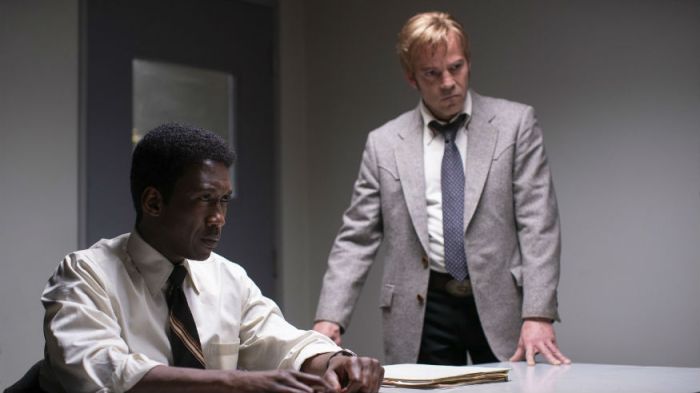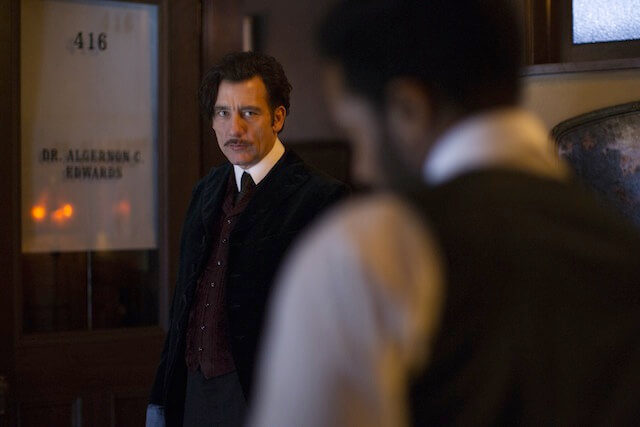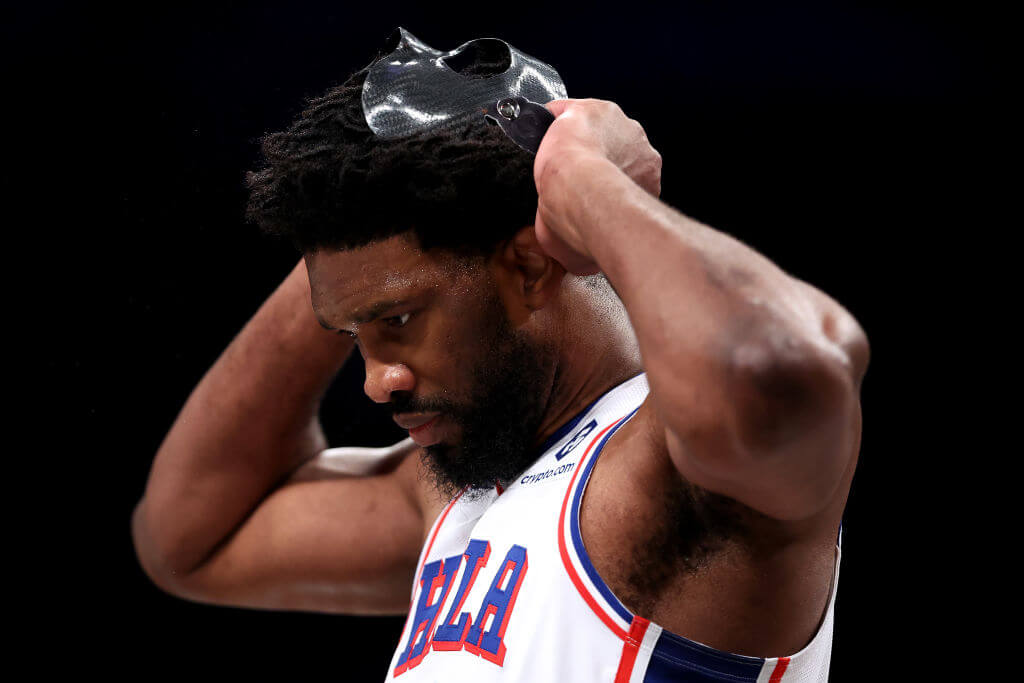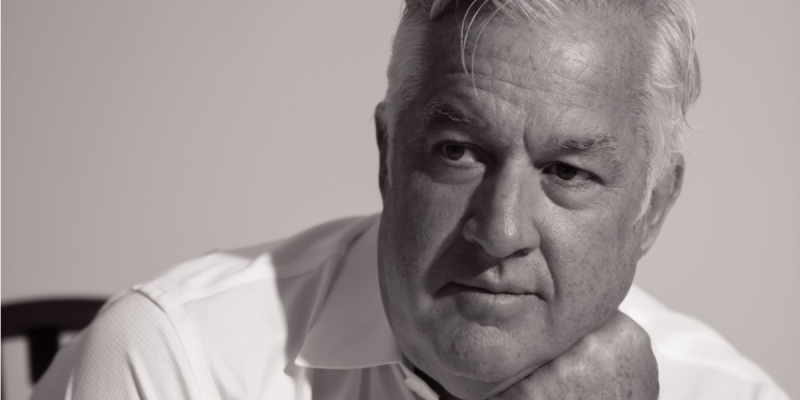A man sits in a chair in the Knickerbocker’s operating theater with his brain open and naked. He is wide awake. We see brilliant junkie surgeon Dr. Thackery (Clive Owen) gently peel back the protective film to get better access. This gross-out moment — reminiscent of the unforgettable Ray Liotta scene in “Hannibal” — comes early in “Whiplash,” the fifth episode of “The Knick”’s second season, but it’s not merely about making us lose our lunch. It succinctly, grossly says everything about what the Steven Soderbergh-helmed and –shot show is doing. Thackery is using this human guinea pig to test which parts of the brain trigger specific emotional responses. He jams a metal pick into one blob and he laughs. He does it to another spot and he cries. Thackery’s manipulating his emotions the way many film and TV makers do. We’re used to, even long for, shows and movies that tell us how to feel and when: the shot of someone experiencing a tragedy or an epiphany as music swells; pratfalls and quips designed to inspire mass cackling. Alfred Hitchcock, in an over-shared quote, boasted of playing the audience like a piano. RELATED: Mohzan Marno on life in Brooklyn and moving up the “Blacklist” Soderbergh doesn’t do this, especially now, and especially with “The Knick,” which might be the most detached and clinical work of an artist who’s been paring his work down over the years to a skeleton. There are plenty of melodramatic fillips on the show, especially in its second season, with teems with broken hearts and fractured relationships. Before this scene Thackery entertained a silent check-up for drug use from his former flame, Nurse Elkins (Eve Hewson), who went from his stalker to his lover to his loyal gofer, and is now a hardened woman who rebuffs suitors and can barely look at the man who broke her heart. Back to the operation, which is really an experiment: Thackery isn’t really out to show how he can manipulate emotions through science, even as he does that to show off to his audience, a smirk across his face. He knows he could actually manipulate emotions if he wanted to. But what he’s really doing is testing, live, whether or not he can find the part of the brain that reacts to drug use. His literally open-headed patient is a morphine addict, and when he’s injected Thackery locates, or thinks he does, the very part of the brain that feeds on it. Rapturous applause. More Thack smirking. The next step, he believes, is to remove it. We won’t find out whether snipping that part out does the job till the episode’s final minutes, and, lo and behold, it does not. He turns the man into a vegetable, partly because, this still being only 1900, science is not an exact science. That’s what “The Knick” is really about. It’s a show where we can reflect on the contrast and the similarities between then and now; it’s a show about progress vs. regression. But it’s also a calm, spiritually scientific show that delights when things prove messy and unpredictable. It’s filmed guerilla-style, very quickly, in a way that looks both rough and polished. It’s largely shot in long takes — long shots that view the action from a remove; close-ups that, when sparingly used, hold so long on one person that we’re not only reading faces and emotions but staring at actors living in the moment. At one point the Knickerbocker is flush with new patients following a subway accident that leaves 160 injured. There is the usual madcap running about, done in acrobatic long takes, recalling the season one peak, “Get the Rope,” the one with the out-of-control race riot. Thackery calmly throws out instructions to his crew, then adds, “Anything else: just make it up as you go along.” That could be written at the top of every one of “The Knick”’s daily call sheets. This belief in extremes fuels “Whiplash” more ostentatiously than usual. It’s an episode firmly tuned to the progress-vs.-regression theme. There’s racial and ethnic business, with Chickering fumbling through a romance with the Jewish journalist he met-cute the previous episode. He’s smitten, but he can’t help but confess that he believes the discrimination against Jews has made them emotionally steely — which he tells to Dr. Edwards (Andre Holland), a member of another persecuted race. There’s also a family dinner where the unease is burst by her making a Jesus-was-a- Jew joke that pushes things so far everyone bursts out laughing. RELATED: 8 “Peep Show” episodes to endlessly rewatch before it returns And of course, there’s Dr. Gallinger (Eric Johnson), who’s been getting in deep with some swanky, bourbon-swilling eugenicists. It finally materializes at his workplace, when he suggests to Thackery that instead of performing an isolated lobotomy on addicts he just give them a vasectomy. The taken-back stare Thack shoots him is priceless, as is Edwards’ instantly disgusted response. He sees right through his claim to the rise of eugenics, which he’s quick to label a “pseudo-science.” Gallinger responds that any true science “always sounds like pseudo-science until it’s accepted as fact.” We, meanwhile, can reflect on all the thought-to-be on-the-level “sciences” that have come and gone and never, luckily, achieved acceptance. Hell, we can think of the anti-vaxers, belief that has yet to be laughed out of existence, despite considerable efforts. “Whiplash” then was just that: about the swing between beliefs, social and scientific, that will live on into the future, and those that will one day die, hopefully before they’ve caused little harm. By episode’s end, Thackery’s belief that you can surgically remove addictive tendencies will have perished within an hour of TV time. Other beliefs will persist. On one side, once bubble-dumb characters are baby-stepping towards accepting Jewish and black characters; on the other, Gallinger, in the eerie final scene/shot, is seen treating young Jewish boys to vasectomies, in his hopes for a future that will luckily never be. Stray token observations:
— Some light (admittedly Wikipedia-fueled) research! At one point Nurse Elkins goes on a date with young aristo Phillip Showalter (Tom Lipinski), who makes her guzzle this delicious cocktail he found in Europe: the Martinez, believed to be one of the originators of the martini. Indeed, the dry martini is, by some accounts, said to have been invented by a bartender at a bar called The Knickerbocker. Coincidence? Maybe! — Is this the first time we’ve seen Barrow’s (Jeremy Bobb) wife? Anyway, she gets a sad scene: On a rare night he’s home, she puts the kids to bed then comes back downstairs in a sexy outfit. “I’m a lucky man to be married to you — everyone says so,” Barrow says with no enthusiasm nor any attempt to make that not sound suspicious. Then it’s back out into the night for more fun than he’d ever have at home, the poor woman left rejected and wailing on the handsome couch paid for by the shady things Barrow is out doing instead. Read our recaps of “The Knick”‘s fourth episode, third episode, second episode and the first.
Recap: ‘The Knick’: Season 2, Episode 5, ‘Whiplash’
Follow Matt Prigge on Twitter @mattprigge























